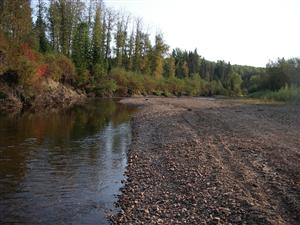Aggregage Mining Development
The process of extracting, processing, and delivering aggregate resources includes the following steps (NCGS 2008):
1. Locating the resource
While some aggregate deposits are found by examining aerial photographs, most are mapped by core-sampling and excavation. Core-sampling determines the depth of the resource, its quality, and the depth of any “overburden”—plants and soils that lie on top of the aggregate resource. The overburden must be removed before the aggregate can be extracted. Because aggregates have a low value per tonne, the amount of overburden has a large effect on whether extraction will be economically viable.
Deposits of sand and gravel in northeastern Alberta occur in pockets, favouring extraction from a single location over a long period, typically years or decades.
2. Mining
Once a deposit of aggregate has been found and the required permits issued, mining can begin.
An active mine requires shovels to move the material from the mine cut to the haul trucks that carry the aggregate to the crusher or sizing facility. The size of the hydraulic shovels and load trucks depends on the size of the mine and the material being hauled. Small pits might only require a small skid-steer loader to move the material and a pick-up truck to transport the material locally. Larger mines use specialized trucks and shovels that can move 100 tonnes or more of aggregate in one load. Because aggregate resources are structurally loose and prone to slumping, open pit mines are generally terraced so that material is less likely to slide or dislodge. This is particularly important for sand and gravel, where terraces are sloped at shallower angles than in crushed rock operations.
Mines that extract crushed stone must first separate the aggregate from the rock face. Operators prepare production blasts by drilling holes and laying explosives that will shear sections of rock from the face. Large jack-hammer drills break the rock into pieces that can then be loaded onto haul trucks to be taken to the crushing facility, where large rocks are reduced in size by one or more crushers.
3. Sizing and storage
A sizing plant separates aggregates of various sizes and quality using screens. The size and quality of the aggregate product are determined by market conditions, and usually vary depending on which products are in high demand. The sorted aggregate products are either stockpiled for sale at the mine site or transported directly to a job site or sales location.
A large amount of water is required to separate sand and gravel from other material, such as silt, clay, soil, and organic matter that is typically mixed in with aggregate deposits. After use, this water is sediment-laden, and must be contained to avoid damaging the aquatic environment from which it was drawn.
4. Cleaning
Cleaning is important because it creates an aggregate product with increased strength, durability, or stability. Washing is commonly done using screens, hydro-separators or settling ponds. In some instances it is economic to separate sand from gravel because each can be sold independently. Aggregate intended for use in asphalt or concrete are typically cleaned prior to sale.
5. Transport
For an end user, transporting the aggregate product from the mine site to where it will be used can cost more than the aggregate itself. As a result, buyers rely on many small local sand and gravel pits, as opposed to sourcing from a few large distant sites (Edwards 1998b). Most aggregate is sold FOB (free-on-board), meaning that the mine will load it into the dump trucks for free, but the purchaser is responsible for all transportation thereafter. Large to medium-sized dump trucks transport the vast majority of all aggregate.
All aggregate pit operators must comply with the requirements of the Environmental Protection and Enhancement Act, and Class II pits (sand and gravel pits over five hectares on private land, and all pits on public land) must also comply with the Alberta Water Act (AENV 2004). The Alberta Guide to the Code of Practice for Pits explains how aggregate pits are regulated. Local municipalities may require permits to allow operation of a pit; these permits may regulate pit location, hours of operation, buffers, noise and dust effects, traffic control and haul routes (AENV 2004).
In Alberta, aggregates are classified as surface materials, exempting them from the Mines and Minerals Act that governs minerals, and making them the property of the land owner (Richards and Peel 2004).









